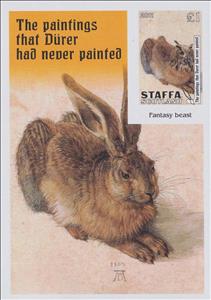Souvenir Sheet: Durer (Scotland, Staffa 2011)
Durer (Scotland, Staffa 2011)
01 January (Scotland, Staffa ) within release Durer goes into circulation Souvenir Sheet Durer face value 1 British shilling
| Souvenir Sheet Durer in catalogues | |
|---|---|
| Colnect codes: | Col: GB-SF 2011-01B |
Souvenir Sheet is square format.
Staffa is an island of the Inner Hebrides in Argyll and Bute, Scotland. According to the PTS Standing Committee reports made in the late 1960's which are fully documented, "Tourists visiting the island can post mail using private local issues in addition to normal postage stamps". The local stamp fees paid for the service of the boatman taking them to the mainland in Oban and having British stamps applied before sending on through the postal system. Numerous covers exist showing proper usage of the labels as per the rules set forth for British local stamp usage. The recommended description by the committee was to call them "tourist souvenir labels". Known covers proving usage exist dating to 1980. Status could change for later usage. Staffa labels were all produced for or by Clive Feigenbaum. Abusive production is proven and later issues are considered bogus as the mailbox used on Staffa for this service was removed sometime in the 1980's. No covers dating after 1980 seem to exist, therefore Staffa labels made after that year, of which the majority date after 1980, are considered to be bogus labels created and produced by Feigenbaum for personal profits from collectors. Bogus catalogs exist claiming all of them to be British Local stamps. Some of these labels in the name of Staffa were used in a tax shelter scheme in the early 1980's of which the defendants were convicted.Also in the issue Durer:
Souvenir Sheet Durer it reflects the thematic directions:
Animals are multicellular, eukaryotic organisms of the kingdom Animalia (also called Metazoa). All animals are motile, meaning they can move spontaneously and independently, at some point in their lives. Their body plan eventually becomes fixed as they develop, although some undergo a process of metamorphosis later on in their lives. All animals are heterotrophs: they must ingest other organisms or their products for sustenance.
Painting is the practice of applying paint, pigment, color or other medium to a solid surface (support base). The medium is commonly applied to the base with a brush, but other implements, such as knives, sponges, and airbrushes, can be used. Painting is a mode of creative expression, and the forms are numerous. Drawing, gesture (as in gestural painting), composition, narration (as in narrative art), or abstraction (as in abstract art), among other aesthetic modes, may serve to manifest the expressive and conceptual intention of the practitioner. Paintings can be naturalistic and representational (as in a still life or landscape painting), photographic, abstract, narrative, symbolistic (as in Symbolist art), emotive (as in Expressionism), or political in nature (as in Artivism). A portion of the history of painting in both Eastern and Western art is dominated by spiritual motifs and ideas. Examples of this kind of painting range from artwork depicting mythological figures on pottery, to Biblical scenes rendered on the interior walls and ceiling of the Sistine Chapel, to scenes from the life of Buddha or other images of Eastern religious origin. In art, the term painting describes both the act and the result of the action. The support for paintings includes such surfaces as walls, paper, canvas, wood, glass, lacquer, clay, leaf, copper and concrete, and the painting may incorporate multiple other materials including sand, clay, paper, plaster, gold leaf, as well as objects. The term painting is also used outside of art as a common trade among craftsmen and builders.


